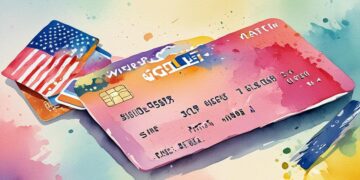How to Create an Emergency Fund While Living in the USA

The Importance of an Emergency Fund
Establishing an emergency fund is crucial for financial stability. It serves as a financial cushion to help you navigate unexpected expenses such as medical emergencies, car repairs, or job loss. Without a dedicated emergency fund, even minor financial shocks can lead to significant stress and debt. Having this fund enables individuals and families to address urgent needs without resorting to high-interest loans or credit cards, which can exacerbate financial difficulties and impact overall credit health.
In the United States, many households experience challenges when it comes to saving. According to recent data, nearly 40% of Americans are unable to cover a $400 emergency expense without borrowing or selling something. This statistic highlights a worrying trend where a large portion of the population is living paycheck to paycheck, making them particularly vulnerable to financial disruptions. The inability to handle such sporadic expenses can lead to longer-term financial insecurity, trapping families in cycles of debt and stress.
Key Components of Building an Emergency Fund
When embarking on the journey to create your emergency fund, consider the following important aspects:
- Set a goal: Aim for three to six months’ worth of living expenses. This range is generally recommended to provide sufficient coverage for essential costs such as rent or mortgage payments, utilities, groceries, and healthcare premiums. For instance, if your monthly expenses amount to $3,000, a robust emergency fund would ideally range between $9,000 and $18,000.
- Choose the right account: Look for high-yield savings accounts or money market accounts to minimize risk while earning interest. These accounts typically offer better interest rates than traditional savings accounts, helping your emergency fund grow over time while still remaining easily accessible in case of urgent need.
- Automate savings: Set up automatic transfers from your checking account to your emergency fund to ensure consistency in your savings plan. By automating your savings, you remove the temptation to spend the money intended for your emergency fund, making it easier to reach your savings goals. For example, you might schedule a monthly transfer of $300 to ensure a steady accumulation of your fund.
By taking these steps, you can secure your financial future and ensure peace of mind. An emergency fund not only alleviates financial strain but also empowers you to make better financial decisions. Knowing that you have a safety net allows you to approach new opportunities, such as changing jobs or investing in your education, with greater confidence. Moreover, maintaining an emergency fund can significantly enhance your overall financial literacy, prompting you to set additional financial goals and work towards achieving them systematically.
In conclusion, the establishment of an emergency fund is more than just a prudent financial strategy; it is a vital component of comprehensive financial planning that contributes to long-term stability and peace of mind.
CHECK OUT: Click here to explore more
Strategies for Effectively Building Your Emergency Fund
Creating an emergency fund may seem daunting, especially in a financial landscape where many people are faced with rising costs and stagnant wages. However, by adopting a structured approach and maintaining discipline, anyone can build a financial safety net. Here are several strategies designed to help you effectively accumulate your emergency fund while navigating the unique economic environment in the USA:
- Assess your financial situation: Before you begin saving, evaluate your current finances. Track your income and monthly expenses to understand how much you can realistically afford to set aside each month. This assessment will provide clarity on your spending habits and highlight areas where you might cut back. For instance, if you identify subscriptions or memberships that you no longer use, eliminating them can free up additional funds for your emergency savings.
- Prioritize savings in your budget: Once you know how much you can potentially save, treat your emergency fund contributions like a fixed expense in your budget. This means setting aside a predetermined amount for your emergency fund before allocating funds to discretionary spending. This approach reinforces the importance of your savings goal and helps ensure that contributions are made consistently.
- Use windfalls wisely: Consider allocating unexpected sources of income, such as bonuses, tax refunds, or gift money, directly into your emergency fund. Instead of spending these influxes, funnel them toward your savings goal. This practice can help you build your fund more rapidly without impacting your regular budget. For example, if you receive a tax refund of $1,500, directing that amount into your emergency savings can significantly boost your progress.
- Review and adjust your goals periodically: Life circumstances can change, necessitating a reevaluation of your emergency fund goals. Regularly assess your monthly living expenses and adjust your savings target based on any changes in your lifestyle or financial situation. If you receive a promotion that increases your salary, consider how that change impacts your ability to save more effectively towards your emergency fund.
By employing these strategies and staying disciplined, you can gradually build a robust emergency fund that serves not only as a financial safety net but also as a source of confidence in your financial decision-making. In an unpredictable economy, knowing you have resources to draw upon during emergencies can significantly reduce anxiety and promote a more secure financial future.
Creating an emergency fund is an essential and empowering step towards financial stability. It enables you to prepare for life’s uncertainties while laying the groundwork for future financial success.
CHECK OUT: Click here to explore more
Utilizing Financial Tools and Resources
In addition to establishing a savings habit, leveraging financial tools and resources can enhance your ability to build an emergency fund more effectively. Here are some practical options available to you in the USA that can facilitate the savings process:
- High-Interest Savings Accounts: One of the most straightforward ways to grow your emergency fund is through a high-yield savings account. Unlike traditional savings accounts, these accounts typically offer a higher interest rate, which can help your savings grow faster over time. Financial institutions such as Ally Bank or Marcus by Goldman Sachs are known for their competitive rates. Research different banks to find the best options and be mindful of any fees that might impact your overall savings.
- Automate Your Savings: Automation can significantly reduce the temptation to spend the money you intend to save. Many banks provide a feature that allows you to set up automatic transfers from your checking account to your savings account on a regular schedule. By setting aside a specific amount, say $100 every payday, you can ensure consistent contributions without the need for active decision-making each month.
- Employ Budgeting Apps: Financial technology has revolutionized the way we manage our finances. Budgeting applications like Mint or YNAB (You Need a Budget) provide tools to help you monitor income, expenses, and savings progress. By providing insights into your financial habits and identifying spending patterns, these apps enable you to adjust and prioritize your saving efforts more effectively.
- Utilize Employer Benefits: Some employers offer financial wellness programs that include resources or even matching contributions for employees saving for emergencies. Take advantage of employer-sponsored savings plans, where applicable, as these benefits can help enhance your contributions and motivate you to save. Check your employee handbook or speak with HR to find available options.
- Consider Side Hustles: In a gig economy, pursuing additional income streams can be an effective way to bolster your emergency fund. Side hustles, such as freelance work, rideshare driving, or selling goods online, can provide a supplementary income that can be directed entirely into your emergency savings. Platforms like Upwork or Etsy present various opportunities for capitalizing on your skills or hobbies while accelerating your savings goals.
It is essential to remain aware of your overall financial health while building your emergency fund. Maintaining the balance between saving and servicing debts is crucial for long-term financial stability. As you explore various financial tools, be cautious about how much you allocate toward your emergency fund versus paying off high-interest debts, such as credit card balances, which can hinder progress toward building a robust financial safety net.
By leveraging these resources and remaining proactive about your saving strategies, you can enhance your ability to create an emergency fund despite the economic challenges of living in the USA. Developing a comprehensive financial plan that incorporates these elements will provide you with not only a safety net but also the empowerment to make informed fiscal decisions moving forward.
CHECK OUT: Click here to explore more
Conclusion
Establishing an emergency fund is a critical component of achieving financial security, especially for residents of the USA, where unexpected expenses can arise at any time. Throughout this article, we have explored a variety of strategies that emphasize the importance of consistent saving habits, the utilization of financial tools, and the exploration of additional income sources as effective means to build a robust safety net.
To summarize, prioritizing the creation of an emergency fund requires disciplined saving practices, a thorough understanding of one’s financial situation, and proactive management of both income and expenditures. For instance, automating your savings by setting up a monthly transfer from checking to savings can eliminate the temptation to spend that money. Utilizing high-yield savings accounts not only safeguards your funds but also allows your money to grow at a faster rate than a standard savings account, accommodating the financial challenges that may arise. Furthermore, leveraging budgeting apps such as Mint or YNAB (You Need A Budget) can facilitate an organized view of your financial landscape, making it easier to identify areas where you can cut back and increase your savings contributions.
In addition to savings strategies, exploring employer benefits such as Health Savings Accounts (HSAs) or Flexible Spending Accounts (FSAs) can further bolster your financial security. Many employers offer programs that can aid in managing healthcare expenses, thereby reducing the financial burden during emergencies. Moreover, engaging in side hustles, whether through freelance work, digital services, or gig economy jobs, can significantly enhance your income stream, providing more resources to allocate towards your emergency fund.
Ultimately, it is imperative to strike a balance between saving for emergencies and managing debt effectively, ensuring that your financial plan remains holistic and sustainable. Continuous monitoring of both your savings and debt levels will provide a clearer picture of your financial health. As you embark on the journey of building your emergency fund, remember that every small contribution counts towards achieving your goal. The peace of mind that comes with financial preparedness is invaluable, empowering you to confront both anticipated and unforeseen challenges with confidence.

Beatriz Johnson is a seasoned financial analyst and writer with a passion for simplifying the complexities of economics and finance. With over a decade of experience in the industry, she specializes in topics like personal finance, investment strategies, and global economic trends. Through her work on Território Deficiente, Beatriz empowers readers to make informed financial decisions and stay ahead in the ever-changing economic landscape.






